

China-Perú: ¿una relación comercial y de inversiones del siglo XIX?
“Nuestro país está dispuesto a intensificar las inversiones en Perú” William Rios Rosales (wrios@editoraperu.com.pe)

The "China Threat" and the Future of Global Science. The United States is in the midst of a contentious trade war with China, which has spilled over to global science.
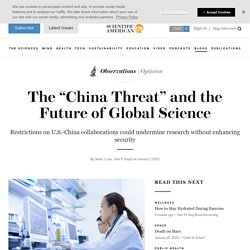
The U.S. federal government has expressed increasing concern about the “China threat” with rising accusations about intellectual theft and espionage coming from China. Over the past year especially, U.S. scientific communites and organizations have been subject to numerous federal proposals and enactments to curb U.S. -China research collaboration. During August 2018, university academic and medical leaders were warned about “classified security threats” coming from “inside” and appealed to partner with the FBI to identify possible espionage.
Under pressure from Congress and in cooperation with the FBI, the National Institutes of Health (NIH), the United States’ largest research funder, urged over 10,000 research institutions to report any international funding and not to share NIH grant application information to those outside the United States. Iniciativa de una franja y una ruta. Territorial Disputes in the South China Sea. The China Dashboard: Fall 2019 Edition. Every quarter Rhodium Group and the Asia Society Policy Institute produce the China Dashboard, a public research initiative that assesses Beijing’s implementation of structural economic reforms based on measurable outcomes, rather than just policy commitments.
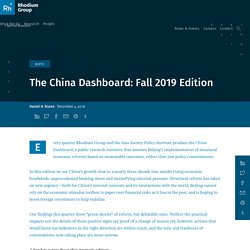
In this edition we see China’s growth slow to a nearly three-decade low, amidst rising economic headwinds, unprecedented banking stress and intensifying external pressure. Structural reform has taken on new urgency—both for China’s internal interests and its interactions with the world. Beijing cannot rely on the economic stimulus toolbox to paper over financial risks as it has in the past, and is hoping to boost foreign investment to help stabilize.
Our findings this quarter show “green shoots” of reform, but debatable ones. A new battleground - In the UN, China uses threats and cajolery to promote its worldview. DESPITE ITS veto-wielding power in the United Nations, China has long been reluctant to stick its neck out.
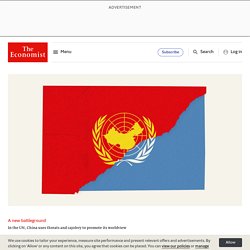
It has been 20 years since it last stood alone in exercising that right. But in the UN’s backrooms, the country’s diplomats are showing greater willingness to flex muscle, and their Western counterparts to fight back. Not since the cold war has the organisation become such a battleground for competing visions of the international order. A struggle in October over China’s mass internment of Uighurs, a Muslim ethnic minority, suggests how intense the fight has become. It involved Britain taking an unusual leading role in condemning China’s human-rights record.
There were threats and reprisals, too. China’s efforts span a broad range of UN activity, from human rights to matters relating to economic development. US–China Strategic Competition: The Quest for Global Technological Leadership. A requiem for the city of Hong Kong. We are likely witnessing the end of Hong Kong as we know it.
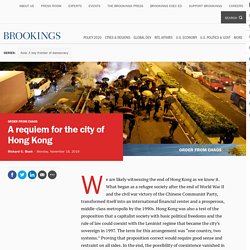
What began as a refugee society after the end of World War II and the civil war victory of the Chinese Communist Party, transformed itself into an international financial center and a prosperous, middle-class metropolis by the 1990s. Hong Kong was also a test of the proposition that a capitalist society with basic political freedoms and the rule of law could coexist with the Leninist regime that became the city’s sovereign in 1997. The term for this arrangement was “one country, two systems.” Proving that proposition correct would require good sense and restraint on all sides. In the end, the possibility of coexistence vanished in clouds of tear gas and flames from petrol bombs. There is the belief that the cause of the current crisis is social and economic inequality, and that if only that problem could be solved the crowds on the street would abandon their protests and life would return to normal.
La neocolonización: cómo es el plan de China para conquistar América Latina y las peligrosas consecuencias. China ha iniciado -desde hace ya algunos años- un lento pero constante proceso de “neocolonización” sin freno.
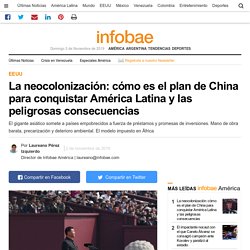
Principalmente en América Latina. Perú podría liderar recepción de las inversiones chinas este año. COSCO SHIPPING Ports PERU (Chancay) Project Official Transfer Ceremony and COSCO SHIPPING Ports Chancay PERU S.A. Promotional Event were Officially Held in Peru. COSCO SHIPPING Ports Limited), a leading ports operator in the world, announced that COSCO SHIPPING Ports PERU (Chancay) Project Official Transfer Ceremony and COSCO SHIPPING Ports Chancay PERU S.A.
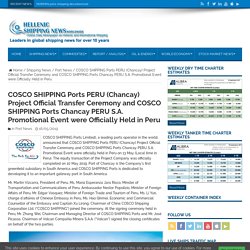
Promotional Event were officially held in Peru on 13 May (Local time in Peru). The equity transaction of the Project Company was officially completed on 10 May 2019. Port of Chancay is the Company’s first greenfield subsidiary in South America and COSCO SHIPPING Ports is dedicated to developing it to an important gateway port in South America. Mr. Martín Vizcarra, President of Peru, Ms. Image: COSCO SHIPPING Ports Limited On 23 January 2019, COSCO SHIPPING Ports officially signed the subscription and investment agreement with Volcan to acquire stake in Port of Chancay. Consorcio Cosco Shipping ampliará en US$723M la inversión en el Puerto de Chancay de Perú.
Lima.
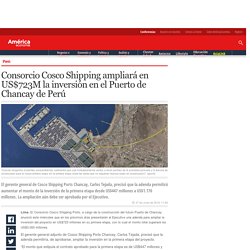
El Consorcio Cosco Shipping Ports, a cargo de la construcción del futuro Puerto de Chancay, anunció este miércoles que en los próximos días presentarán al Ejecutivo una adenda para ampliar la inversión del proyecto en US$723 millones en su primera etapa, con lo cual el monto total superará los US$3.000 millones. El gerente general adjunto de Cosco Shipping Ports Chancay, Carlos Tejada, precisó que la adenda permitiría, de aprobarse, ampliar la inversión en la primera etapa del proyecto.
“El monto que estipula el contrato aprobado para la primera etapa es de US$447 millones y esta adenda permitirá ampliar la inversión a US$1.170 millones”, manifestó tras su participación en el foro ‘Mecanismos de facilitación de la Inversión Privada’ organizado por Proinversión. Cosco Shipping proyecta ampliar inversión en US$723 millones para puerto de Chancay – Energiminas. 3 Análisis: sobre el II Foro de la Nueva Ruta de la Seda Beijing China 2019 – Dossier Geopolitico.
Aportes para el Análisis de Dossier Geopolitico DG, sobre la última Reunión en Pekín del II Foro sobre la Iniciativa de la Franja y la Ruta, incorporamos Tres artículos.
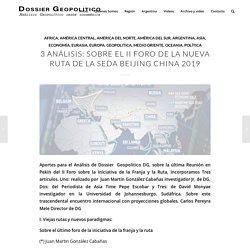
Uno: realizado por Juan Martin González Cabañas investigador Jr. de DG, Dos: del Periodista de Asia Time Pepe Escobar y Tres: de David Monyae investigador en la Universidad de Johannesburgo, Sudáfrica. Sobre este trascendental encuentro internacional con proyecciones globales.